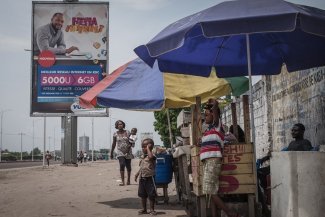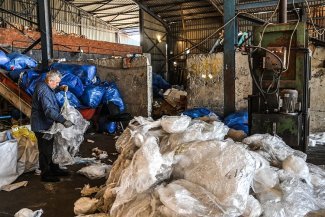The 415-year-old Si-o-seh Pol (The Bridge of 33 Arches) in Isfahan, Iran now stands over the dead Zaiandehroud River due to desertification.
Khuzestan Province, in south-east Iran, is known for its enormous oil and gas reserves, which play a vital role in country’s oil industry. The oil-rich province is commonly referred to as the region that makes the money that the entire country needs. In recent years, Ahvaz, the capital of Khuzestan has earned a new title as one of the world’s most polluted cities. In fact, Ahvaz has the highest particle pollution levels in Iran.
On 7 February, a strong sandstorm hit Ahvaz, shutting down schools and government offices. The storm, which lasted for a week, caused power cuts in the province and temporarily reduced Iran’s average oil production of 3.8 million barrels per day (bpd) to 3.1 million.
Iranian authorities have placed the blame on neighbouring countries, saying that Iraq and Saudi Arabia caused the sandstorm by failing to tackle desertification in their respective territories.
In an interview with domestic media, Iran’s vice-president and environment minister, Masoumeh Ebtekar, downplayed Iran’s role in the current environmental crisis in Khuzestan by claiming: “Environmental issues in Iraq and Saudi Arabia account for 65 percent of the sandstorms in Iran.”
However, environmental experts and water resource managers have a different viewpoint.
“Four decades of implementing water transfer plans and constructing dams in Iran has deeply changed the country’s landscape,” Samaneh Pour Achraf, an irrigation engineer who has worked on several water management projects in Iran told Equal Times.
“Lagoons and rivers have dried up due to Iran’s dam policy,” she added.
“Several wetlands across the country have been turned into wastelands. The Hoor Al-Azim wetland was once a water resource in Khuzestan, but it is now depleted and has become a sand resource for the sandstorms hitting the province.”
The water crisis is not unknown to the Iranian authorities. In December 2016, Energy Minister Hamid Chitchian declared that the country’s water resources had reached critical levels. According to a report by the United Nations Development Program, by 2025, the level of Iran’s per capita water resources will fall to about one-third of its level in 1990.
In response, the government has mainly focused on plans to keep the water flowing in the pipelines of the capital Tehran and big cities such as Isfahan, Shiraz, Mashhad and Tabriz. However, water shortages and water rationing is common in smaller cities in central Iran and on the Iranian coast of the Persian Gulf and the Gulf of Oman.
Dams in arid lands
Hamoun, Uroumieh, Bakhtegan, Parishan and Tashk are Iranian lakes and lagoons that have shrunk by somewhere between 80 and 100 per cent over the last decade. Zaiandehrood, meaning the river that gives life, has also dried up in the historic city of Isfahan. Before dying, the Zaiandehrood was the biggest river in the central Iranian plateau.
Drought and climate change are not the only reasons for the environmental disaster occurring in this arid country. Poor management of water resources has also caused irreversible damage to Iran, a country with about 250mm of rain a year – less than a third of the global average.
A University of Malaya study, conducted by Iranian researchers, pointed out: “The environmental effects are not considered fully and completely for the most dams have been constructed in Iran.”
According to this research, the construction of the Sivand Dam, built in 2007 in Fars Province, has been a disaster “destroying thousands of acres of grassland” in central Iran. As a direct result of the dam, Bakhtegan – Iran’s second largest lake – dried up, turning the lake into a graveyard of migrating flamingos.
And Sivand is not the only dam in Iran that has had a negative environmental impact. Iran ranks third in dam building internationally, after China and Turkey.
During the last four decades, Iranian officials – irrespective of their political leanings – have hailed dam construction as a sign of rapid development, successful revolutionary management and an independent economy.
This political rhetoric has been the main inspiration for constructing over 600 large, middle and small size dams in Iran since the 1979 revolution. However, not only has this policy not been a solution to the country’s water crisis, but it has also accelerated desertification.
“The authorities in Iran never talk about the submergence of land in the upstream of dams, disruption to animal life, causing serious geological damage, and the drowning of historical sites behind the dams,” Pour Achraf explained.
“Recent studies in Iran have also shown that dam construction has a direct role in inundating upstream forests and decreasing downstream timberlands which eventually leads to desertification.”
Through the last two decades, desertification has severely affected Kerman Province, also in south-east Iran. Farmers have been forced to abandon over 8,330 villages in the province due to desertification, drought and water mismanagement. Many of them are now struggling to make a living in nearby cities
Hojat Abad is a village in the Takab region of Kerman Province, about 1,100 kilometres from Tehran. Two decades ago, its farmers could grow rice, watermelons and cucumbers on their agricultural lands. Nowadays, dying palm tress are the only plants remaining in the village.
“Today you can only see dusty sands in the village, but once it was all green,” said Ali Vakili, 47, one of the few remaining residents of Hojat Abad. “When our qanat [traditional system of water supply in Iran] dried up, all the farms were covered by sand and people started to leave their ancestral houses.”
The fantasy of diverting water
Ambitious water transfer projects have also deepened Iran’s water crisis. Two major projects in Iran aim to transfer desalinated water from the Caspian Sea to the central Semnan Province and to move water from the Oman Sea in the south of the country to Iran’s central plateau.
“Long distance water transfer is not a sustainable solution for the water crisis as long as the main causes of the crisis are not dealt with,” stresses Hamid Norouzi, an Iranian professor at New York City College of Technology.
“Wherever you touch the environment, it will have negative impacts. Inter-basin water transfer plans manipulate the environment enormously and such projects will eventually show their negative impacts.”
According to Norouzi, the long-term effects of water transfer projects can vary from damaging the ecosystem of donor regions to the displacement of communities.
Despite the objections of water management experts and environmental activists, the President of Iran, Hassan Rouhani, dedicated a budget of US$400m to launch the Caspian Sea project on March 2016. Rouhani introduced the project under pressure from Iran’s most powerful security, military, political and economical organization, the Islamic Revolutionary Guard Corps (IRGC), which later became the main contractor for the project.
Since the 1960s, a number of water transfer plans have been implemented in Iran to divert water from the Zagros mountain range in the west to Iran’s central arid region.
As a result, the Zaiandehrood River died in Isfahan and the Karoun River lost half of its flow rate in Khuzestan. Nevertheless, authorities still persist in making use of dated and ill-fitted water management techniques to control the water crisis in Iran.
In Norouzi’s opinion, a comprehensive plan, that takes into account all aspects of the water crisis, is required. “Iran needs a plan that makes functioning dams operate better, that finds a way to reuse water, a plan that considers urbanisation and growth of population in Iran and even looks into matters like changing crops in the agriculture section,” Norouzi said.
“Building a dam or implementing a water transfer plan without considering all of the environmental aspects of such projects will not solve the issue.”









